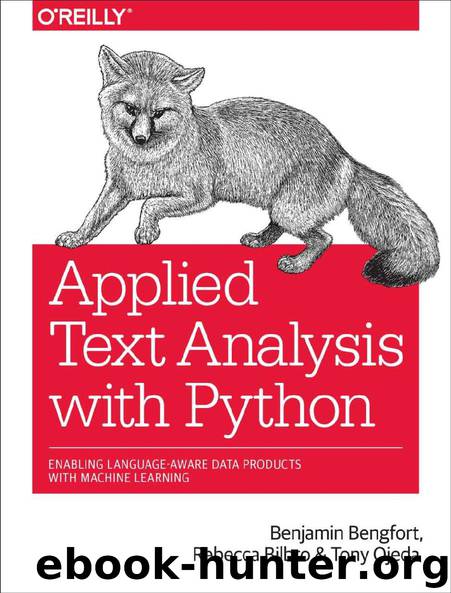Applied Text Analysis with Python: Enabling Language-Aware Data Products with Machine Learning by Benjamin Bengfort & Rebecca Bilbro & Tony Ojeda

Author:Benjamin Bengfort & Rebecca Bilbro & Tony Ojeda [Bengfort, Benjamin]
Language: eng
Format: epub
Publisher: O'Reilly Media
Published: 2018-06-10T23:00:00+00:00
... # First make the matrices # By frequency mtx = matrix(text,cast) # Now create the plots fig, ax = plt.subplots() fig.suptitle('Character Co-occurrence in the Wizard of Oz', fontsize=12) fig.subplots_adjust(wspace=.75) n = len(cast) x_tick_marks = np.arange(n) y_tick_marks = np.arange(n) ax1 = plt.subplot(121) ax1.set_xticks(x_tick_marks) ax1.set_yticks(y_tick_marks) ax1.set_xticklabels(cast, fontsize=8, rotation=90) ax1.set_yticklabels(cast, fontsize=8) ax1.xaxis.tick_top() ax1.set_xlabel("By Frequency") plt.imshow(mtx, norm=matplotlib.colors.LogNorm(), interpolation='nearest', cmap='YlOrBr')
To create the alphabetic view of the co-occurrence plot, we begin by alphabetizing the list of characters and specifying that we want to work with the second subplot, (122), and add the axes elements much in the same way as for the first subplot:
Download
This site does not store any files on its server. We only index and link to content provided by other sites. Please contact the content providers to delete copyright contents if any and email us, we'll remove relevant links or contents immediately.
The Mikado Method by Ola Ellnestam Daniel Brolund(20603)
Hello! Python by Anthony Briggs(19899)
Secrets of the JavaScript Ninja by John Resig Bear Bibeault(18208)
The Well-Grounded Java Developer by Benjamin J. Evans Martijn Verburg(17575)
OCA Java SE 8 Programmer I Certification Guide by Mala Gupta(17422)
Kotlin in Action by Dmitry Jemerov(17185)
Algorithms of the Intelligent Web by Haralambos Marmanis;Dmitry Babenko(16235)
Grails in Action by Glen Smith Peter Ledbrook(15390)
Sass and Compass in Action by Wynn Netherland Nathan Weizenbaum Chris Eppstein Brandon Mathis(13266)
Test-Driven iOS Development with Swift 4 by Dominik Hauser(10393)
Windows APT Warfare by Sheng-Hao Ma(7833)
Layered Design for Ruby on Rails Applications by Vladimir Dementyev(7548)
Blueprints Visual Scripting for Unreal Engine 5 - Third Edition by Marcos Romero & Brenden Sewell(7448)
Solidity Programming Essentials by Ritesh Modi(4566)
Functional Programming in JavaScript by Mantyla Dan(4436)
Hands-On Full-Stack Web Development with GraphQL and React by Sebastian Grebe(4430)
WordPress Plugin Development Cookbook by Yannick Lefebvre(4382)
Unity 3D Game Development by Anthony Davis & Travis Baptiste & Russell Craig & Ryan Stunkel(4270)
The Ultimate iOS Interview Playbook by Avi Tsadok(4252)
